 |
 |
 |
| |
Changing Epidemiology of HCV Infection:
Unsafe Injections and Other Modes of Transmission
(prevention/screening/heroin/cascade of care/IDUs)
|
| |
| |
- HCV prevention, Heroin Use/HCV, HCV Increases Among Young, Updated HCV Testing Recommendations, Treatment as Prevention, Cascade of HCV Care, Screening & Testing Serving PWIDs CDC Funded Sites, Treatment to Reduce HCV prevalence Among IDUs
AASLD/EASL Special Conference on Hepatitis C
New York City, New York
September 12 - 13
John W. Ward, M.D.
Division of Viral Hepatitis
Centers for Disease Control and Prevention
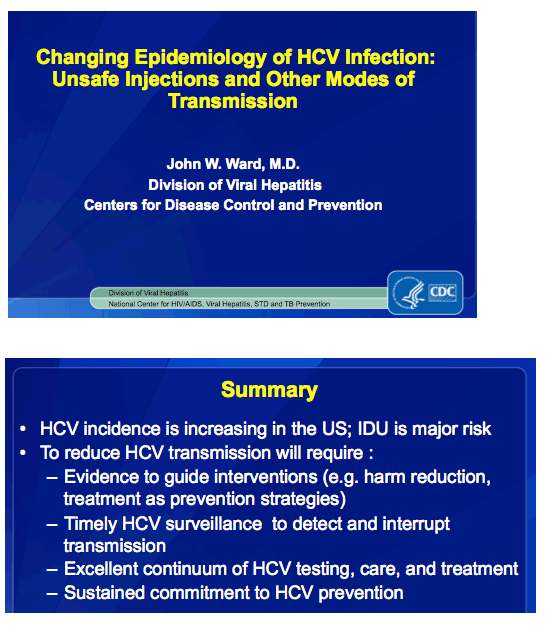

Nelson PK, Lancet 2011, Hagan et al. 2010; Garfein et al. 1998; 2Armstrong et al. 2006, Amon et al. 2008;
3 Klevens et al. 2013; Daniels et al. 2007; Amon et al. 2008 ; Weissing L, PlosOne 2014
---------------------------------
from Jules:
Estimating the Number of Persons Who Inject Drugs in the United States by Meta-Analysis to Calculate National Rates of HIV and Hepatitis C Virus Infections- (05/30/14)
"we estimate that approximately 774,434 adults and adolescents (range: 494,605-1,054,263) injected drugs in the past year in the United States......Using data from national population-based U.S. surveys, we estimated that persons who ever injected drugs comprised 2.6% (CI: 1.8%-3.3%) of the U.S. population. This represents approximately 6,612,488 million PWID (range: 4,583,188-8,641,788) aged 13 years or older in 2011. Although PWID comprise 3% or less of the U.S. population, they account for 22% of all persons living with HIV infection"
Table 4. Estimated proportion of persons who inject drugs (PWID) in the United States, by sex, race/ethnicity, and age group-meta-analysis of 3 national surveys.*
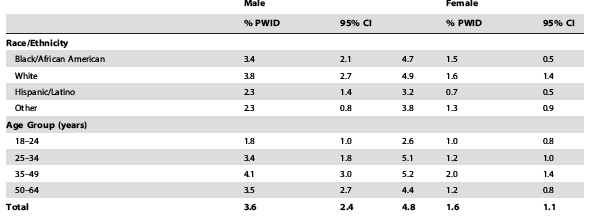
New NHANES: The Changing Epidemiology of Hepatitis C Virus Infection in the United States: National Health and Nutrition Examination Survey 2001 through 2010.......http://www.natap.org/2013/HCV/011314_12.htm......."Injection drug use remains the strongest risk factor for HCV infection.[47-49]
........The prevalence was noted to be highest among male non-Hispanic Blacks (2.2%) compared to Non-Hispanic whites (1.3%) [2.9% among Black men, 1.7% among Black women].
---------------------------------
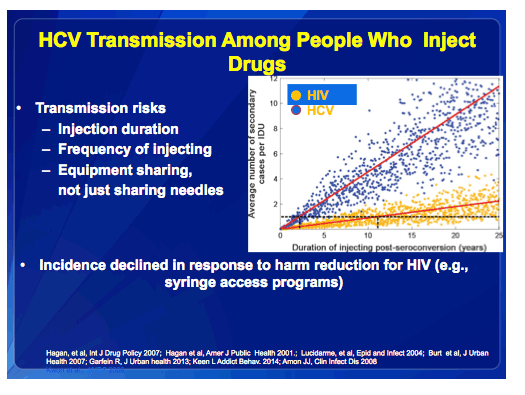
Transmission risks include how often they inject, and whether they sharing equipment. Data from Australia, suggests that Hep C is transmitted much more quickly than HIV.
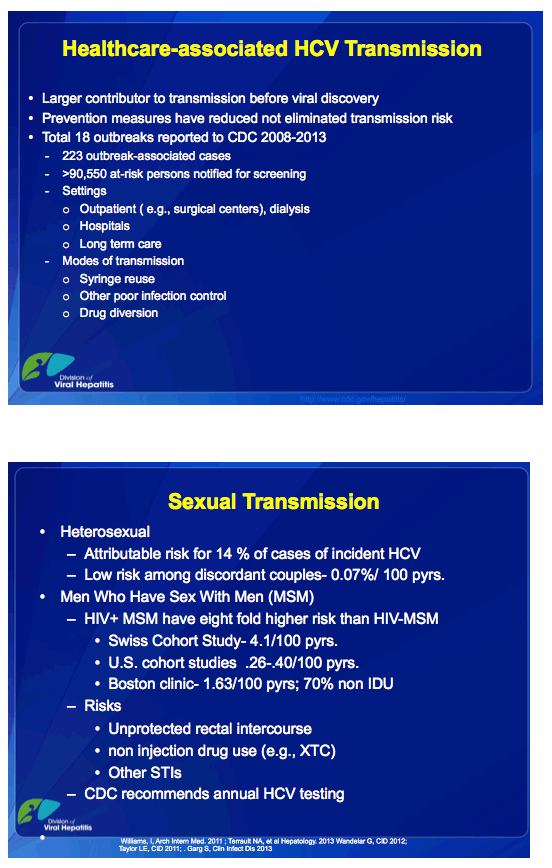
---------------------
from Jules:
HCV Sex Transmission, Early Reports from 1995/2002 Among Men, Women at Johns Hopkins STD Clinics & other Studies, HIV+ MSM from the Netherlands.......http://www.natap.org/2014/HCV/022414_02.htm .........HCV Sexual Transmission - 2 studies below from 1995 at Johns Hopkins STD Clinics finding HCV sex transmission among non-IDU men & women, mostly African-Americans, & in Netherlands among HIV+ MSM; and links below to studies from 2002/2003/2006 reporting the same, particularly sex transmission to non-IDU heterosexual HIV+ women........Females with anti-HCV-positive sex partners were 3.7 times more likely to have anti-HCY than females with anti-HCY-negative sex partners.......frequent in male and female patients who had greater numbers of sex partners (even after adjusting for age and other associated factors), and anti-HCY was associated with other sexually transmitted diseases, such as HIY and Trichomonas infections.......Women & HCV.....http://www.natap.org/2002/june/060302_1.htm
-----------------------------
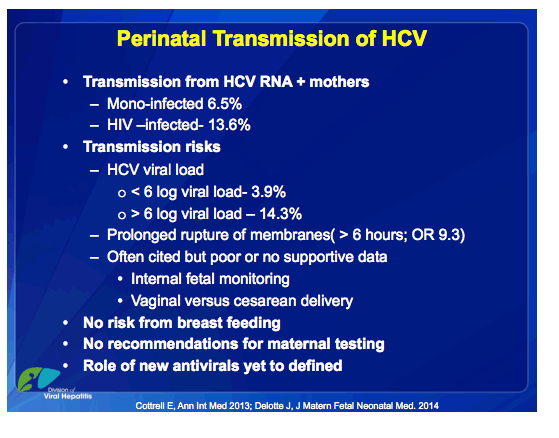
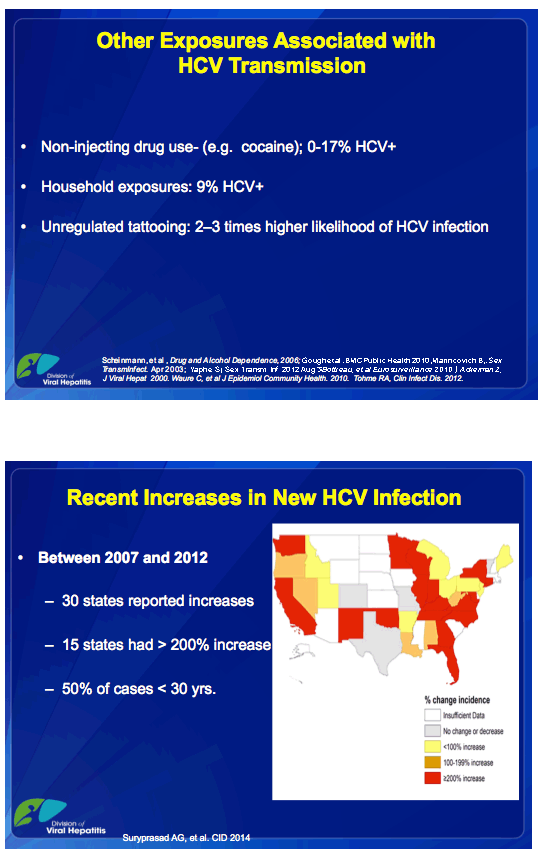
Between 2007 and 2012, reports of new HCV infection increased 50% nationally. Seventeen states
reported a 200% increase. At least seventy percent of those infections are related to injection
drug use which often begins with the abuse of oral prescriptions narcotics among older
adolescents and young adults. These individuals are predominately white adolescents and
young adults residing in suburban and rural areas.

----------------------
from Jules:
Emerging Epidemic of Hepatitis C Virus Infections Among Young Non-Urban Persons who Inject Drugs in the United States, 2006-2012 - (08/20/14)
Clinical Infectious Diseases Advance Access published August 11, 2014.....Anil G. Suryaprasad1........data from U.S. opioid treatment programs-a major venue for HCV testing-do not suggest significant changes in the proportion of U.S. programs offering testing during our study period......."These data indicate a worrisome increase in HCV infection among young PWID in the United States. The incidence of reported acute hepatitis C among young persons has significantly increased during 2006-2012, with annual increases over two times greater in non-urban compared to urban jurisdictions.....During 2006-2012, 7,169 cases of acute hepatitis C were reported to CDC. Of 7,077 cases with reported age, 44% were aged ≤30 years. Of these, approximately 1% were aged ≤5 years. In 2012, 49% of all U.S. cases were aged ≤30 years, versus 36% in 2006"
Changing Hepatocellular Carcinoma Incidence and Liver Cancer Mortality Rates in the United States..... "US liver cancer mortality rates increased with age in all racial/ethnic groups..... Among individuals aged 50-64 years, blacks had the highest mortality rate (18.6), followed by Hispanics (13.5), Asians/Pacific Islanders (13.0), and whites (7.7)." - (05/05/14)
http://www.natap.org/2013/HCV/013113_01.htm.......Hepatitis C cases climbing in NKY......Almost 88 percent (of those tested) had a history of IV drug use......Many of those tested have been in the age group of 20-29
Kentucky ranks No. 1 for the bloodborne virus.......http://www.wcpo.com/news/local-news/boone-county/florence/heroin-surge-presents-hepatitis-c-attack-on-northern-kentucky........The state of Kentucky is No. 1 in the nation with 4.1 hepatitis C cases per 100,000 residents, according to the U.S. Centers for Disease Control. That rate far surpasses the national average of 0.6 people per 100,000. And in Northern Kentucky, the rate is off the chart: 13 per 100,000, according to the Northern Kentucky Health Department. With the ongoing surge of heroin users, the wave of hepatitis C patients is mounting, many of them undiagnosed. Since 2010, hepatitis C cases have increased by more than 80 percent in Northern Kentucky, with 23 cases reported in 2010, 42 cases in 2011 and 52 in 2012.
----------------------
Download the PDF here
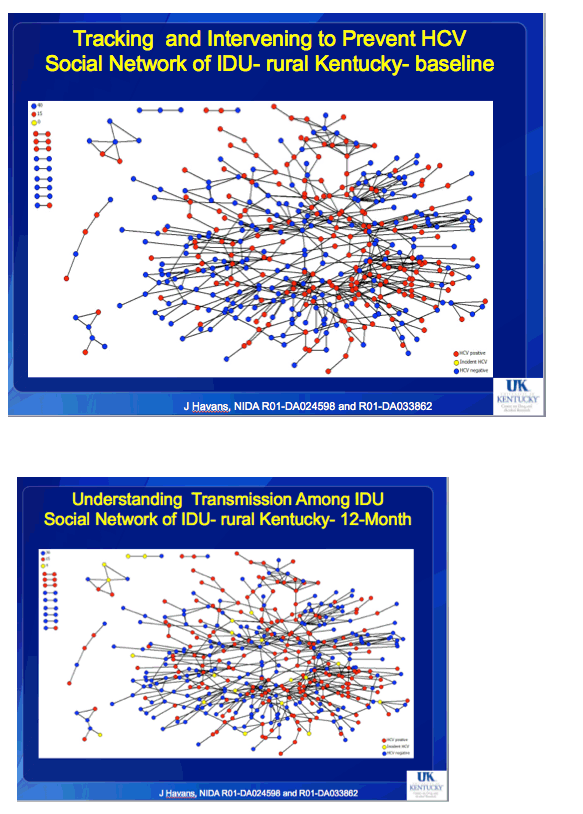
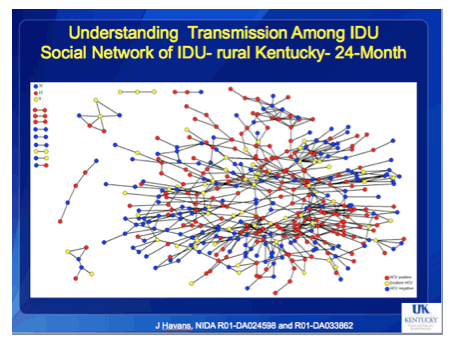
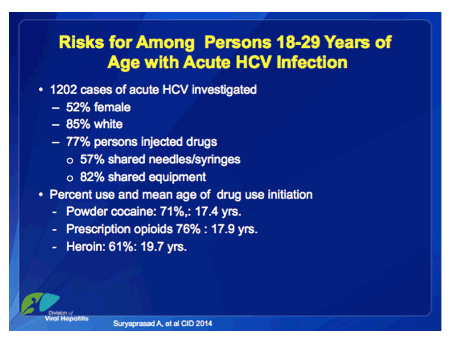
----------------------
from Jules:
Emerging Epidemic of Hepatitis C Virus Infections Among Young Non-Urban Persons who Inject Drugs in the United States, 2006-2012 - (08/20/14)
Clinical Infectious Diseases Advance Access published August 11, 2014.....Anil G. Suryaprasad1........data from U.S. opioid treatment programs-a major venue for HCV testing-do not suggest significant changes in the proportion of U.S. programs offering testing during our study period......."These data indicate a worrisome increase in HCV infection among young PWID in the United States. The incidence of reported acute hepatitis C among young persons has significantly increased during 2006-2012, with annual increases over two times greater in non-urban compared to urban jurisdictions.....During 2006-2012, 7,169 cases of acute hepatitis C were reported to CDC. Of 7,077 cases with reported age, 44% were aged ≤30 years. Of these, approximately 1% were aged ≤5 years. In 2012, 49% of all U.S. cases were aged ≤30 years, versus 36% in 2006"
-----------------------

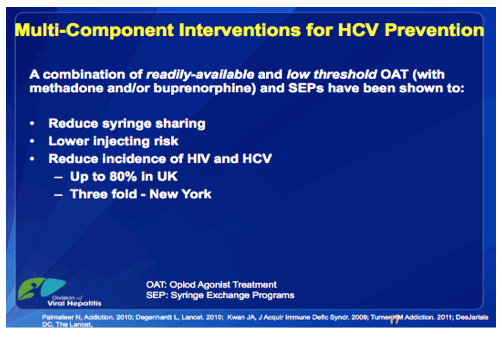
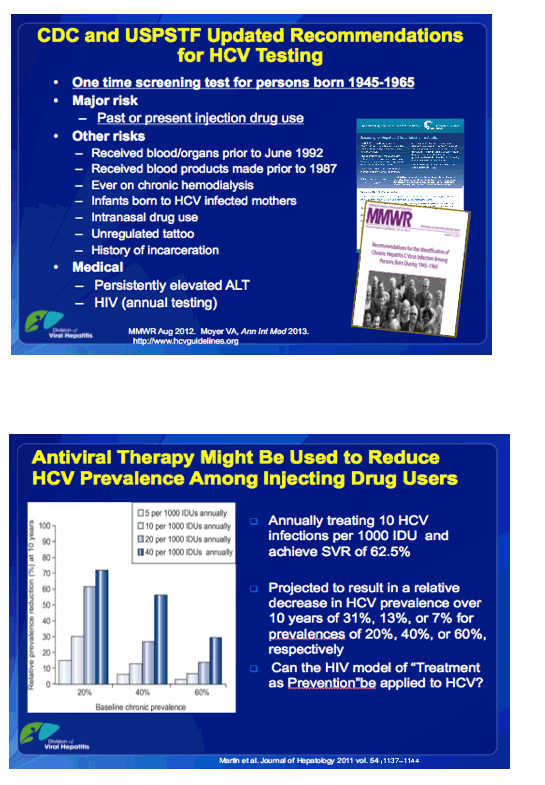
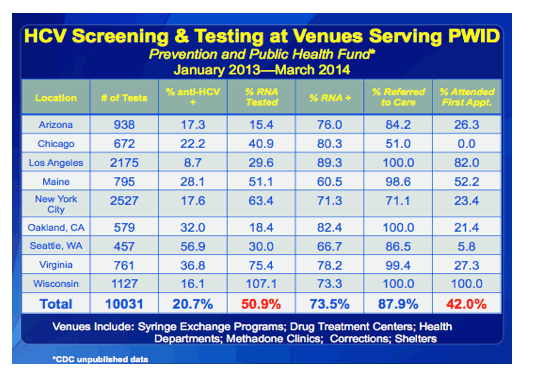
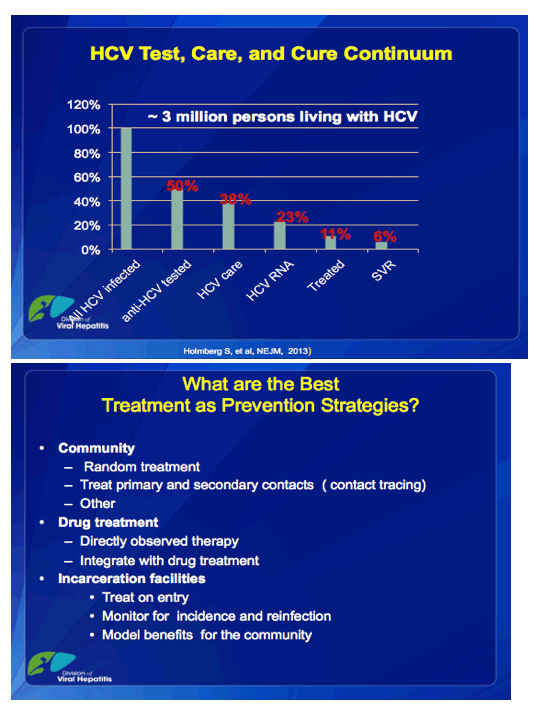

In summary, there are several positive signs amidst an array of challenges.
Public awareness campaigns and community mobilization are generating broader recognition that HCV needs to be addressed now.
The CDC and USPSTF baby boomer screening recommendation should be implemented such that opt out screening occurs. This would both improve provider screening and reduce the stigma that has been a barrier to HCV screening and care.
HCV screening can be more simple than the current two-step process of diagnosis that is confusing to many patients and even some providers.
Change to HCV surveillance policies to allow for negative HCV viral load results to be reported to surveillance would make HCV surveillance much more useful in tracking our progress.
Expanding HCV treatment to primary care providers and ensuring access for patients with less severe fibrosis is essential.
Many HCV drugs are in the pipeline right now; the approval of them should generate competition and may help with the barrier of high cost.
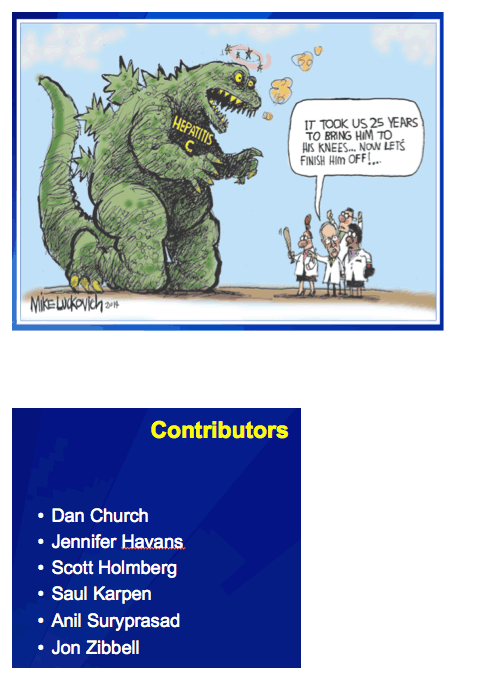
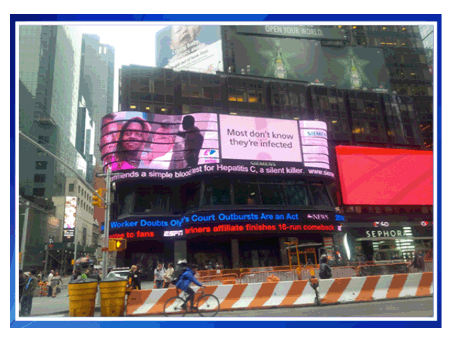
|
| |
|
 |
 |
|
|